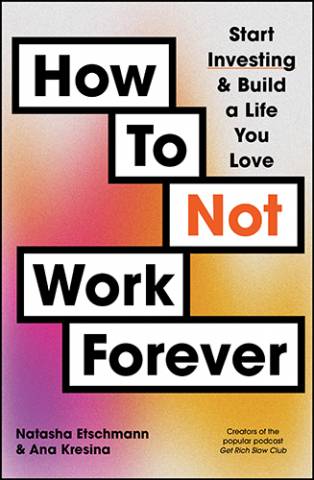How to Not Work Forever

'How to Not Work Forever'- first book from financial educator @tashinvests shows how investing in shares and ETFs helps build the life you want
Does the idea of not working forever appeal? Because life is for living, right? The reality is that your salary alone isn't enough to fund your ideal lifestyle, but if you make some smart money moves today, you can live your dream life tomorrow. In the new book, How to Not Work Forever (Wiley $32.95, 26 June 2024), financial educators Natasha Etschmann and Ana Kresina, co-hosts of the popular Get Rich Slow Club podcast, outline a simple yet effective strategy to attain real financial freedom: start investing, start small and start now.
In this jargon-free, super practical guide, Tash and Ana guide readers through their approach to investing in shares, ETFs and index funds, showing exactly what to invest in, when to sell, and how to navigate taxes, fees, and other hurdles on your path to financial success. With plenty of real-life case studies, readers learn how to:
- make the money to invest & boost your earning power
- set goals and create a holistic money strategy
- understand the share market, ETFs and index funds
- factor your superannuation into your plans for your future
- confidently build your own personalised investing strategy.
Written for anyone looking to break free from the daily grind, How to Not Work Forever provides you with the tools you need to create a roadmap, start investing wisely and build a life you love. Author Natasha Etschmann is a content creator, founder of @tashinvests and co-host of the Get Rich Slow Club podcast with Ana Kresina. Co-author Ana Kresina is a financial educator and the Head of Product and Community at investment platform, Pearler. Her previous book, Kids Ain't Cheap was released in 2023.
How to Not Work Forever
by Natasha Etschmann
Wiley Amazon
RRP: $32.95
Simple ways to set up a budget you'll actually stick to
Think of budgeting as a tool to help you build a life that you love. Once you have a grasp of your budget and spending, you can allocate money towards investing, which will ultimately build wealth and help you work towards your goal (of not working forever).
What comes to mind when you hear the terms 'budget' or 'cash flow'? Is it something super restrictive, boring and complicated? Or is it just a plan for your money that enables you to reach your goal?
Tracking your spending allows you to:
- create a realistic budget (hard to do if you don't know what life is costing you)
- be in control of your finances and make informed decisions
- allocate money to things that you value and bring you joy.
How much you can invest really comes down to understanding your cash flow. Having a good cash flow or budgeting system is important because you don't want to over-invest and not have enough money available for expenses.
Remember that you only lose money when you sell, and you want to avoid needing to do this at times such as market downturns. It's important that you do not rely on the money you've invested for any short-term goals or emergencies. As a rule of thumb, any money you invest in shares you should be prepared to leave alone for at least 7 years.
Knowing how much you want to invest each week, fortnight or month will also help you decide which investing platform is best for you. They all have different minimums and fees based on investment amounts.
You can budget by tracking your spending and knowing where your money goes, or you can create a budget and allocate money for expenses and investing. The goal is to know how much money you have available to put aside for investing.
How to track your spending
There are many different ways you can track your spending and budget. Find a way that works for you and your lifestyle, and one that's sustainable. If one method doesn't work for you, trial another!
Here are some popular ways to track your spending:
- Print out your bank statements and highlight wants vs needs in different colours. Does your spending reflect your goals and values?
- Track your spending in a journal for a week, fortnight or month. A month will give you the best overall picture.
- Every time you spend money, jot down how you feel to make yourself more mindful of your spending habits.
- Use Excel or Google Sheets to keep track of every time money comes in/out of your bank account.
Budgeting apps
One of the easier ways to start tracking your spending and getting a good idea of your finances is by using an app.
Popular budgeting apps include:
- PocketSmith
- Frollo
- Canstar
- YNAB (you need a budget).
Budgeting apps can give you a holistic view of where you're spending money and allow you to budget and track all of your expenses.
Splitting expenses
Another way to budget is by allocating a specific percentage of your income to each of your different spending categories. You could start by dividing your income into three categories:
- 50 per cent for needs (bills, housing, car)
- 30 per cent for wants (entertainment, going out, takeaway)
- 20 per cent for savings, investments and paying off debt
This is a good method to use when you aren't sure where to start, because it's automated and you don't have to think about it too much.
Someone on a lower income may need to spend more than 50 per cent on needs, while someone with a higher income might be able to save and invest more than 20 per cent of their income.
Zero-based budgeting
This is something for everyone who loves to be in control of every dollar.
Zero-based budgeting involves assigning every dollar a specific purpose or job, so you know exactly where each dollar is going. This is a very detailed way to budget and you will feel right on top of your finances, but it is time consuming, may limit flexibility and can be very overwhelming.
It does, however, provide you with control over every dollar and it lets you scrutinise each expense (which can be very insightful if you've never done this type of budgeting before).
Pay yourself first
This method involves prioritising saving and investments by treating them like bills. You start by automatically setting aside a portion of your income for saving and investing and then allocating the remainder of your funds to expenses.
Pay yourself first is good for knowing exactly how much you are going to save each month, but can be challenging for those who don't have a good grip on their finances yet. For example, if you invested first and then realised you had a few bills coming that you hadn't accounted for, you may need to sell your investments, take money out of savings or use credit to cover these costs, all of which are best avoided.
If you can't manage $100, it will be really hard to manage $1 million. Just imagine if you're living off your dividends in the future and you've chosen a work-optional life. Even then, you'll need to be able to manage your money. That's why this knowledge about budgeting should set you up on your way to building a life you love.
Edited extract from How to not work forever by Natasha Etschmann and Ana Kresina (Wiley $32.95), available 26 June at all leading retailers.
Disclaimer: Any information here is general in nature and has been prepared without considering your personal goals, financial situation, or needs. Because of this, before acting on the general advice, you should consider its appropriateness, having regard to your unique situation. You should obtain and review the Product Disclosure Statement (PDS) and Target Market Determination (TMD) relevant to the product before making any financial product decisions. It's also strongly encouraged to seek the advice of a professional financial adviser.
MORE



